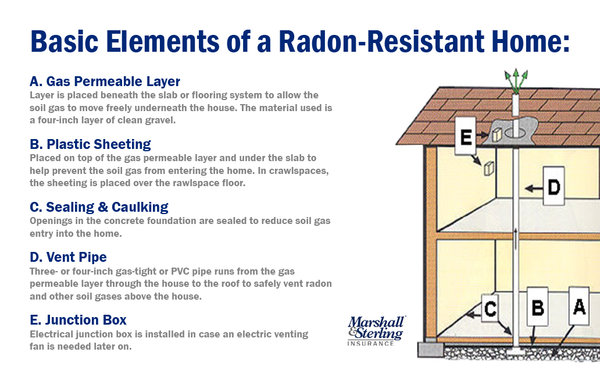Does Your Home Have A Radon Problem?
Radon, a colorless and odorless gas, is the leading cause of lung cancer in nonsmokers - causing an estimated 21,000 lung cancer deaths per year. In an effort to alert homeowners, the Environmental Protection Agency (EPA) has designated January as National Radon Action Month.
The EPA Estimates 1 out of 15 Homes Has Dangerous Levels of Radon
Radon is a naturally-occurring radioactive gas produced by the breakdown of uranium in soil, rocks and water. From there, it can make its way into any environment or building. Since air pressure in your home is generally lower than the pressure in the soil around the foundation, your home acts like a vacuum and draws radon gas in through the cracks in the foundation and through other openings. Radon may also be present in your water source and can be released into the air when water is used for household purposes such as showering, or ingested when drinking. As a result, the EPA and the Surgeon General both recommend testing all homes below the third floor for radon.
Fortunately, it’s easy to test your home. Radon test kits can be obtained through the mail and at some hardware stores. It’s also possible to contact a certified radon specialist to test your home for you. There are two common types of tests:
Short-term test: These tests stay in your home for two to 90 days, depending on the specific model. A short-term test can be a great way to get a quick idea of your home’s radon levels. However, radon levels can vary throughout the year, so these tests may not give an accurate reading of your home’s average annual radon level.
Long-term test: These tests stay in your home for longer than 90 days. As a result, they can give you an idea of your home’s average radon level.
When testing with a home kit or a radon specialist:
- Close your house to the outdoors (windows and doors) for at least 12 hours prior and during a short-term test.
- Do not disturb or move the testing device.
- Promptly send the testing unit and all required information to the laboratory as soon as the test is complete.
- Do not perform a radon test during severe storms or periods of high winds.
- Place the test at least 20 inches above the floor in a location where it cannot be disturbed. It should also be away from drafts, high heat, high humidity and exterior walls.
Radon levels are measured in picocuries per liter of air (pCi/L). The EPA estimates the average indoor radon level to be about 1.3 pCi/L, and recommends that homes should have no more than 4 pCi/L. If your home contains a dangerously high amount of radon, you may need to install a removal system to ventilate the gas outside.
There are no discernible early signs of radon poisoning. However, you should always be mindful of early signs of lung cancer, which can be caused by continued exposure to radon gas. If any of your family or employees complain of a worsening cough, coughing up blood, chest pain, shortness of breath, wheezing or repeated respiratory infections, encourage them to see a doctor for diagnostic care and early detection.
Reducing Radon Levels In Your Home
There are several things you can do to reduce the radon level in your home:
- Seal cracks and other openings in the foundation of your home.
- Hire a qualified radon reduction specialist to install a radon mitigation system in your home for approximately $800 to $2,500, and in less than one day. These systems prevent gas from entering the home from below the concrete floor and from outside the foundation. The right system for your home depends on its design and other contributing factors.
- If your home’s water source has high levels of radon, a qualified radon reduction contractor can install a point-of-entry treatment device to reduce the level of radon in the water that comes into your home.
Tips For Hiring A Professional
Before hiring someone, get more than one estimate, check their references and make sure the hired contractor has the proper certifications. The contractor should be qualified to do the following for you:
- Review testing guidelines and measurement results.
- Evaluate the radon problem and provide you with a detailed, written proposal on how radon levels will be lowered.
- Design a radon reduction system and install it according to EPA standards and/or state or local codes.
- Assure that the finished system effectively reduces radon levels to acceptable levels.
At Marshall & Sterling Insurance, we want to make sure that your home is properly covered! Please let us know how we can help you with your insurance needs when purchasing a new home or building from the ground up.



